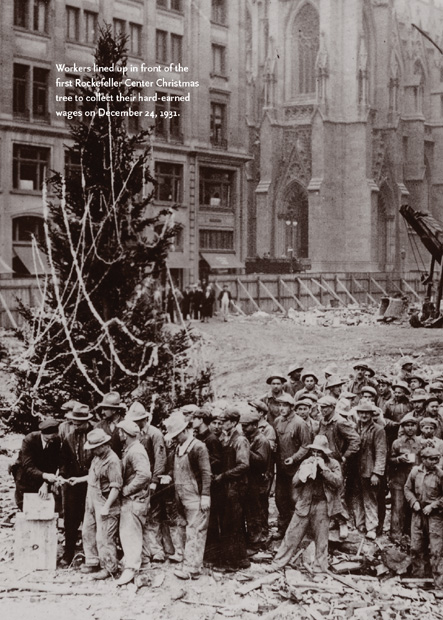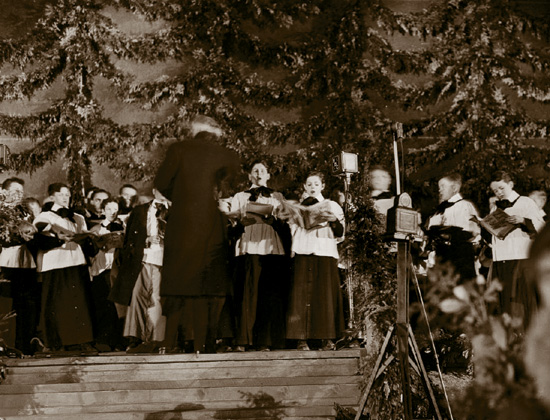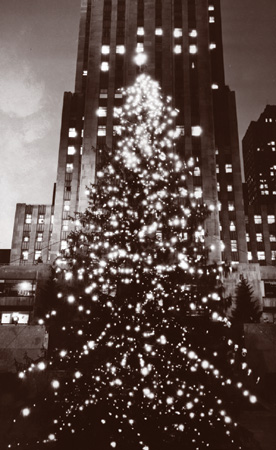



The Rockefeller Center Christmas Tree: The History & Lore of the Worlds Most Famous Evergreen
Copyright 2010 by Cider Mill Press Book Publishers LLC
All rights reserved under the Pan-American and International Copyright Conventions.
13-Digit ISBN: 978-1-60433-101-1
10-Digit ISBN: 1-60433-101-1
eISBN: 978-1-60433-236-0
Please support your local bookseller first!
Books published by Cider Mill Press Book Publishers are available at special discounts for bulk purchases in the United States by corporations, institutions, and other organizations. For more information, please contact the publisher.
Cider Mill Press Book Publishers
Where good books are ready for press
12 Port Farm Road
Kennebunkport, Maine 04046
Visit us on the web!
www.cidermillpress.com
www.SimonandSchuster.com
Designed by PonderosaPineDesign.com, Vicky Vaughn Shea
Typography: Adobe Caslon, Dingbats, Linotype Decorations, Love Letter Typewriter, Olduvai, Salmiak, Seria Sans
Photo & iIllustration credits: cover, page 6 Xinhua/Landov; cover, page 9 www.Shutterstock.com/Mario Bruno; back cover, page 138 iStockphoto.com/Shawn Gearhart; back cover iStockphoto.com/Tomasz Pietryszek; back cover Jorge Moro; back cover flap iStockphoto. com/Boris Yankov. All interior photos up to 1995 Rockefeller Group, Inc. 2008, after 1996 Tishman Speyer Rockefeller Center 2008. With the exception of: page 8 www.Shutterstock.com/Nialat; page 9, 13 www.Shutterstock.com/Karlionau; page 10 www.Shutterstock.com/mvprint; page 19 iStockphoto.com/Rafal Fabrykiewicz; page 23 www.Shutterstock.com/Travis Manley; page 28 www.Shutterstock.com/Alan Linn; page 31 www.Shutterstock.com/Eric Issele; page 41 www.Shutterstock.com/Yury Asotov; page 53 www.Shutterstock.com/Petrov Stanislav Eduardovich; page 60 www.Shutterstock.com/Patricia A. Phillips; page 63 www.Shutterstock.com/FloridaStock; page 73 www.Shutterstock.com/Kavram; page 74 www.Shutterstock.com/Gregory James Van Raalte; page 107 Marc Averette; page 120, 125 www.Shutterstock.com/Andrew F. Kazmierski; page 123 Leando Karunungan http://flickr.com/scubapup; page 128 www.Shutterstock.com/David N. Madden; page 130 iStockphoto. com/appleuzr
1 2 3 4 5 6 7 8 9 0
First Edition

TABLE OF CONTENTS

ACKNOWLEDGMENTS
T his book could not have been completed without the generous help and support of several people. First and foremost, I wish to thank Christine Roussel, archivist at Rockefeller Center, a fascinating and intelligent person who has an odd and sometimes lonely job. Her impressive organization and entertaining insights were instrumental in bringing this book to fruition. Also deserving thanks are Alexandra Lewis and Vicky Vaughn Shea; without their keen eyes and creativity, this book would never have made it to press. My deepest gratitude goes to the friends and family members who have listened to me talk about Christmas trees all spring, but most of all, to Jack Curran, who tolerates me through the solitary and often frustrating process of writing a book better than most and provides endless moral support.


{ Chapter 1 }
THE BEGINNING
O n December 24, 1931, Rockefeller Center was not much more than a gaping hole between 49th and 50th streets in Midtown Manhattan. The average onlooker would likely have passed by with little more than a dull glance, unaware that the foundation work had begun on one of the most ambitious private building at that time. Even if he had known, however, he may have been indifferent, for he had a more pressing concern weighing on his mind: a worldwide economic downturn. By the time the centers construction began, the country was waist-deep in the Great Depression, and New York City seemed to feel the crippling effects of this economic crisis more than any other city in the country. Unemployment figures were staggering, and sixty-four percent of New Yorks construction workers were jobless. For the most part, construction had come to a halt across the city. But John D. Rockefeller Jr.s center, which would comprise nine main buildings and two smaller structures, created jobs for thousands of people, people who were so thankful to have work that they took it upon themselves to erect the very first Christmas tree in Rockefeller Center.
As each man approached the clerk, who was standing next to the tree distributing the wages, he must have thought himself a part of a true Christmas miracle.

In December of 1933, the Paulist Choristers opened a week of Christmas caroling and other musical performances at the foot of the majestic Rockefeller Center Christmas tree.
That first tree was a simple twenty-foot balsam, which the workers draped with makeshift garlands and tin cans as decoration. Its presence imbued a festive air to an already celebratory experience as the men lined up next to the tree to receive their paychecks that Christmas Eve in 1931. For some, it was their first paycheck in weeks, if not months. As each man approached the clerk, who was standing next to the tree distributing the wages, he must have thought himself a part of a true Christmas miracle.

In 1935, an eighty-foot tree sparked brilliantly in front of the RCA building.
Looking back, over seventy-five years later, this auspicious beginning of a much beloved and storied tradition seems almost too heart-warming to be true, and yet this is actually the way it all began. In the years that followed, technological advances, environmental awareness, national television exposure, and even contributions from gardening experts have made the Rockefeller Center Christmas tree an extreme spectacle, a much bigger production than that first celebration in 1931. Throughout the traditions nearly eight decades, though, the spirit of that first tree has endured. It wasand continues to bea symbol of joy, peace, and, most of all, hope for the millions of people who gaze at it every year during the holiday season.

{ Chapter 2 }
A TRADITION IS BORN
T he Norway spruce has been the variety of evergreen most often selected as the Rockefeller Center Christmas tree since the tradition began. The reason? This species of spruce grows to daunting heights, often more than one hundred feet tall, and it continues to mature throughout its impressive lifespan of eighty to one hundred years. The spruce also grows fairly quickly, at a rate of about one foot per year.
Next page


















